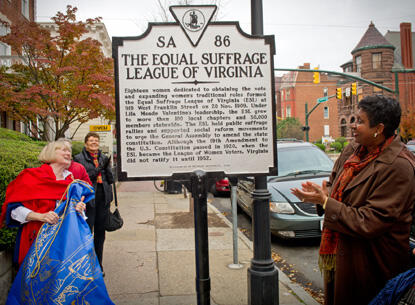
Nov. 21, 2012
Virginia recognizes VCU’s historic landmark for women’s rights
Share this story
Virginia Commonwealth University commemorated the women’s suffrage movement on Tuesday, exactly two weeks after a tight U.S. presidential election in which female voters played an integral role.
Marking the 1909 founding of the Equal Suffrage League (ESL) of Virginia, an organization that advocated for women’s right to vote, VCU Libraries, the College of Humanities and Sciences and the Department of Gender, Sexuality and Women's Studies sponsored a VCU Year of Freedom event to celebrate the unveiling of a new Virginia Historic Marker at the Crenshaw House, 919 W. Franklin St.
Guests included women from the Virginia League of Women Voters, a representative of the Virginia Department of Historic Resources, members of the university community and even a descendant of the Crenshaw family. Remarks centered on the history of the home and the significance of the 103-year anniversary of the ESL’s work.
“There are two types of people in this world. There are people who watch things happen, and there are people who make things happen,” said Wanda Mitchell, Ed.D., founding vice president of diversity and equity at VCU. “These women were the kind of people who made things happen.”
The ESL led the movement in Virginia for women’s suffrage for 10 years and would become the Virginia League of Women Voters in 1920, the same year the 19th Amendment to the U.S. Constitution was ratified, giving women the right to vote. Among the 20 founding members were some of Richmond’s most prominent women of the day including Anne Clay Crenshaw, social reformer Lila Meade Valentine, artist Adele Goodman Clarke and author Ellen Glasgow. Their first meeting took place on this same day at in 1909 at the Crenshaw House, home of Anne Clay Crenshaw and her family.
The fourth annual Crenshaw Lecture followed, featuring Lorraine Gates Schuyler, historian and chief of staff in the Office of the President at the University of Richmond, who spoke on the topic, "After the Right to Vote." She is the author of “The Weight of Their Votes: Southern Women and Political Leverage in the 1920s,” published in 2006.
Schuyler outlined some of the challenges women and minorities faced post-suffrage when trying to register and vote. Many tactics were employed to ensure their vote didn’t count, including cumulative poll taxes, literacy tests, intimidation and fraud. Groups like the ESL worked to educate women and mobilize them to vote.
The state historical marker, issued by the Virginia Department of Historic Resources, states: “Eighteen women dedicated to obtaining the vote and expanding women’s traditional roles formed the Equal Suffrage League of Virginia (ESL) at 919 West Franklin Street on 20 Nov. 1909. Under Lila Meade Valentine’s leadership, the ESL grew to more than 100 local chapters and 30,000 members statewide. The ESL held public suffrage rallies and supported social reform movements to urge the General Assembly to amend the state constitution. Although the 19th Amendment to the U.S. Constitution passed in 1920, when the ESL became the League of Women Voters, Virginia did not ratify it until 1952.”
The Crenshaw family lived in the house for nearly 40 years. It was purchased by Richmond Professional Institute, now VCU, in the 1960s. It was renamed the "Crenshaw House" on Nov. 20, 2009, 100 years to the day that the first ESL meeting took place.
“Voting and women’s rights have always been important issues to our family,” said Sally Witt, granddaughter of Anne Crenshaw, who was delighted and proud of her family’s emancipatory history. “I’ve never missed an election since I could first vote at age 21 (the former minimum age to vote).”
More than just the hostess of the first two meetings of the ESL, Anne Clay Crenshaw was a link between 19th and 20th century attempts by women to win suffrage in the commonwealth. She also served as an important liaison in the early days of the ESL between its Richmond organizers and national leaders of the movement. Her life in Richmond is representative of many other like-minded women of the city who became active in the cause for suffrage in Virginia.
Today the Crenshaw House is listed in the Virginia Landmarks Register and the National Register of Historic Places. A slideshow about the house and the ESL can be viewed here: http://www.dhr.virginia.gov/SlideShows/CrenshawHouse/CrenshawTitleslideNOV.html.
Virginia’s historical highway marker program, which began in 1927 with the installation of the first historical markers along U.S. Route 1, is considered the oldest such program in the nation. Currently there are more than 2,200 official state markers, most maintained by the Virginia Department of Transportation, as well as by local partners in jurisdictions outside of VDOT’s authority such as Richmond.
Subscribe to the weekly VCU News email newsletter at http://newsletter.news.vcu.edu/ and receive a selection of stories, videos, photos, news clips and event listings in your inbox every Thursday.
Subscribe to VCU News
Subscribe to VCU News at newsletter.vcu.edu and receive a selection of stories, videos, photos, news clips and event listings in your inbox.



